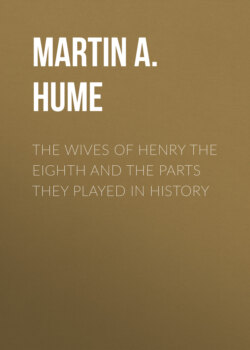Читать книгу The Wives of Henry the Eighth and the Parts They Played in History - Martin A. S. Hume - Страница 4
На сайте Литреса книга снята с продажи.
PREFACE
ОглавлениеTable of Contents
Either by chance or by the peculiar working of our constitution, the Queen Consorts of England have as a rule been nationally important only in proportion to the influence exerted by the political tendencies which prompted their respective marriages. England has had no Catharine or Marie de Medici, no Elizabeth Farnese, no Catharine of Russia, no Caroline of Naples, no Maria Luisa of Spain, who, either through the minority of their sons or the weakness of their husbands, dominated the countries of their adoption; the Consorts of English Kings having been, in the great majority of cases, simply domestic helpmates of their husbands and children, with comparatively small political power or ambition for themselves. Only those whose elevation responded to tendencies of a nationally enduring character, or who represented temporarily the active forces in a great national struggle, can claim to be powerful political factors in the history of our country. The six Consorts of Henry VIII., whose successive rise and fall synchronised with the beginning and progress of the Reformation in England, are perhaps those whose fleeting prominence was most pregnant of good or evil for the nation and for civilisation at large, because they personified causes infinitely more important than themselves.
The careers of these unhappy women have almost invariably been considered, nevertheless, from a purely personal point of view. It is true that the many historians of the Reformation have dwelt upon the rivalry between Katharine of Aragon and Anne Boleyn, and their strenuous efforts to gain their respective ends; but even in their case their action has usually been regarded as individual in impulse, instead of being, as I believe it was, prompted or thwarted by political forces and considerations, of which the Queens themselves were only partially conscious. The lives of Henry’s Consorts have been related as if each of the six was an isolated phenomenon that had by chance attracted the desire of a lascivious despot, and in her turn had been deposed when his eye had fallen, equally fortuitously, upon another woman who pleased his errant fancy better. This view I believe to be a superficial and misleading one. I regard Henry himself not as the far-seeing statesman he is so often depicted for us, sternly resolved from the first to free his country from the yoke of Rome, and pressing forward through a lifetime with his eyes firmly fixed upon the goal of England’s religious freedom; but rather as a weak, vain, boastful man, the plaything of his passions, which were artfully made use of by rival parties to forward religious and political ends in the struggle of giants that ended in the Reformation. No influence that could be exercised over the King was neglected by those who sought to lead him, and least of all that which appealed to his uxoriousness; and I hope to show in the text of this book how each of his wives in turn was but an instrument of politicians, intended to sway the King on one side or the other. Regarded from this point of view, the lives of these six unhappy Queens assume an importance in national history which cannot be accorded to them if they are considered in the usual light as the victims of a strong, lustful tyrant, each one standing apart, and in her turn simply the darling solace of his hours of dalliance. Doubtless the latter point of view provides to the historian a wider scope for the description of picturesque ceremonial and gorgeous millinery, as well as for pathetic passages dealing with the personal sufferings of the Queens in their distress; but I can only hope that the absence of much of this sentimental and feminine interest from my pages will be compensated by the wider aspect in which the public and political significance of Henry’s wives is presented; that a clearer understanding than usual may thus be gained of the tortuous process by which the Reformation in England was effected, and that the figure of the King in the picture may stand in a juster proportion to his environment than is often the case.
MARTIN HUME.
London, October 1905.
